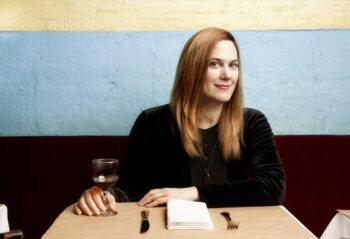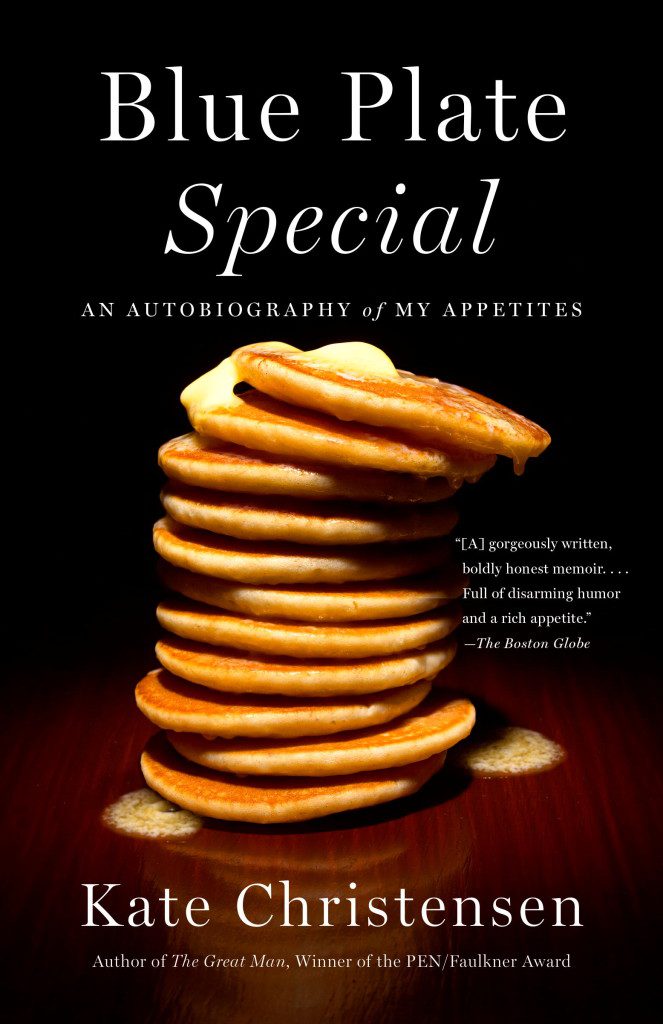
The late phenomenal woman herself, Maya Angelou, is often quoted as saying, “I’ve learned that people will forget what you said, people will forget what you did, but people will never forget how you made them feel.” One thing she forgot—what they were eating when you made them feel it. Food is both necessity and extravagance, personal and universal, background and main character.
Mind you, I write this as a finicky non-foodie. I’ve never met a dish I couldn’t special-order. But some of my most vivid memories are centered around food—the simpler, the better. Love is my mom braving a hot, hissing deep fryer to make my favorite popcorn chicken. Loss is the best cinnamon waffles I’ll never eat again, at a diner that suddenly closed, with a person who stopped loving me.
In Blue Plate Special: An Autobiography of My Appetites, six-time novelist Kate Christensen writes: “In recent years, my life had started to intrude on my writing. It first announced itself as a subject quietly but insistently, as subjects will if you let them, the way a cat might sit on a book you’re trying to read.” When Christensen was finally ready to tell her own story, tracing her relationship with food was the rawest, most accessible way she knew how. The memoir, now available in paperback, starts with soft-boiled eggs and childhood trauma in 1960s Berkeley and traces a lifetime of meals savored, deferred, relished, and restricted. By the end, reader and writer alike are sated by Christensen’s satisfyingly unpretentious Blue Plate Special.
***
The Rumpus: Let’s talk about the origins of Blue Plate Special. Instead of immediately working on a book, you started a blog. Why was blogging a better start to telling your own story?
Kate Christensen: Writing blog posts is totally freeing in a whole new way for me. I’m not writing it for any editor, and I’m not being paid, so I can say whatever I want. I don’t have to justify the cost of a book to readers; they get it for free, so expectations are naturally low. (And no one-star reviews!)
I knew I wanted to write the story of my life in food—I was inspired by M.F.K. Fisher and Laurie Colwin, most of all. Starting the blog was a way for me to generate this nonfiction first-person voice naturally, gradually, without feeling performance anxiety. It felt a bit like keeping journals when I was younger, but connecting to an instant readership without having to wait for publication made it also immediately satisfying. Blogging is different from both journal-writing and writing for print. It’s more fun than either of those. The freedom to write whatever I want and the unmediated connection with readers are the payoff.
Turning the blog into a book was extremely difficult, a tremendous amount of sustained, hard work. Blogging is easy; writing a book is difficult.
Rumpus: I stopped blogging when my freelancing picked up a few years ago. Now my first instinct is to write something with a paying publication in mind. Anything I write for free is personal, a bigger project I might be able to sell in the future, or done purely out of love. How do you balance what’s for your blog and what gets published elsewhere?
 Christensen: Although the point of blogging is that it doesn’t pay, I often steal from my blog for paid publication. I’ve based several magazine essays on blog posts, as well as an entire book. I’m currently working on a second nonfiction book, How to Cook a Moose, using my blog posts about life in Maine and New Hampshire as the cornerstone for the historical and culinary and cultural research I’m doing.
Christensen: Although the point of blogging is that it doesn’t pay, I often steal from my blog for paid publication. I’ve based several magazine essays on blog posts, as well as an entire book. I’m currently working on a second nonfiction book, How to Cook a Moose, using my blog posts about life in Maine and New Hampshire as the cornerstone for the historical and culinary and cultural research I’m doing.
Another benefit is that the more I blog, the more I maintain and develop a first-person voice, which translates into a much greater ease with writing personal essays. Sometimes I think of blogging as finger exercises for a violinist; sometimes I think of it as mulching a garden. It is incredibly useful and helpful to my “real” writing. I’ve always subscribed to the notion that a writer always has something else to say, and the more you write, the more you have to write about, because the act of writing is self-generating.
Rumpus: Do you read a lot of blogs?
Christensen: My mother’s blog is my favorite. It’s a riveting, passionate, poignant, well-written account of being a solo tent camper by a seventy-eight-year-old woman.
I also read a variety of food blogs, among them Michael Ruhlman, Amy Chaplin, Orangette, Poor Man’s Feast, Gluten Free Girl, Gluten Free Gus, Kimchi and Meatballs, Foie Girl… So many, and there are more. I also follow a few blogs of writers and artists I admire, among them Andrea Scrima and Gabrielle Bell.
Rumpus: How did writing nonfiction compare to writing fiction?
Christensen: It’s both harder and easier. For me, it comes from a very different well. I am much more interested in nonfiction right now. For years and years, writing novels was a way for me to delve into things I couldn’t go into any other way. I was very lonely and had a lot of unresolved shit kicking around my head from my own life. Inventing characters and allowing them to say and do things I couldn’t say or do for a variety of reasons was like having avatars or proxies to fight my battles for me, to express what needed expressing. It was also a way out of the extreme loneliness that plagued me all my life until recently.
Now that I no longer feel lonely, and now that my own past feels resolved in a whole new and very deep way, I am excited to write about the real world, to stay in it. Fiction is an escape, a parallel life, and it was a powerful source of comfort for me when my own life was raw and uncomfortable. I don’t feel the burning need to disappear into a fictional character these days.
Rumpus: Why was food the focus as you told the story of your life? Why not music or clothing or some other thread to hold it all together?
Christensen: I’m really not a hardcore foodie at all. I’m an enthusiastic eater and passionate amateur cook. I wanted the title to suggest a plain, straightforward, unadorned meal without anything fancy—no big epiphanies, for example, I resisted the urge to analyze, explain, and interpret. I wanted the story to speak for itself to any readers who could find comfort or reassurance in it. Meat and three veg, that’s what this book is.
So many of my memories are generated by and organized around food: what I ate, what people cooked, what I cooked, what I ordered in a restaurant. My mental palate is also inextricably intertwined with the verbal part of my brain. Food, words, memories all twist together, so it was the obvious way to structure my life. Each memory of food opened up an entire scene for me, it was the key that unlocked everything.
I was also writing in a tradition and trying to do something different with it, something that hadn’t necessarily been done before, which was a risk, but it made it interesting. My relationship with food has been complicated and rocky and not always wonderful, and it’s a lens through which my entire life and identity are refracted. I wanted to capture time through how food and I were getting along at any given moment. That necessitated writing some dark stuff, some sad stuff, and a lot of painful memories, because my life has often been dark, sad, and painful. I didn’t want to sugarcoat anything.
Rumpus: As I read, I found myself trying to identify the ever-shifting meaning of food. In some sections, it’s love. In others, it’s control through deprivation or escape by binging. Women especially have such complicated relationships with food.
Christensen: I know I do. The pressure to be thin, which causes guilt and obsessiveness around food, is terrible and starts so early. For me, it started at sixteen when I left home and gained weight for the first time and was told by a slightly older boy, out of the blue, that I was “too plump.” The shock of that lasted a good long time. And the teacher I worked for as an au pair for room and board, who very clearly didn’t like me, was constantly on me about my weight, as if she were trying to help me, which of course she wasn’t: “You’re getting fat again, Katie.” When you’re sixteen and struggling to forge an identity out of a morass of hormones and daydreams, remarks like that cut a deep groove in the brain. I trace the ongoing, victorious-feeling semi-starvation of my twenties directly back to adolescence—as a way of showing those assholes that I could control my appetites… Which is so sad, in retrospect, because of course no one cared.

And of course as an adult I generally feel this pressure to be thin, not from men, but from other women. As a silent or not-so-silent competition, a constant monitoring of who’s thinner, comments about it—either compliments or veiled insults doesn’t matter—it always drives me nuts. My mother wasn’t obsessed with her weight; that didn’t come from her. I’m not obsessed with other women’s weight at all, just my own, to avoid the glances and remarks. For me, gluttony can be a rebellion against this prevailing orthodoxy of slenderness, a “fuck you” to it—which isn’t healthy, either. But yes, so many women in this country share this to some degree, at least many of the women I know.
But the older I get, the easier it is to recapture the deep, simple, urgent animal pleasures of eating I felt naturally as a kid, before any neurotic dysfunction crept into eating.
Rumpus: Tell me about the recipes throughout the book.
Christensen: The two or three recipes at the end of every geographical section are meant as a continuation of the story and a thematic reverberation as much as, or even more than, they’re meant to function as actual recipes. I started playing with recipe conventions in my blog, using them as storytelling devices, and I extended that to the book.
Rumpus: In the book, you describe the different solitary experiences of writing your novels. What was it like as you wrote Blue Plate Special? What did you eat as you wrote it?
Christensen: I had to detach myself from myself, if that makes any sense, to conjure an authentic first-person voice. In that sense, it was similar to writing a first-person novel. But I was writing about real people, not fictional ones—myself, my family, my friends and boyfriends and ex-husband, and that was extremely tricky. I didn’t want to offend or hurt anyone, to cause any rifts or anger, but there was no way to avoid it in a couple of cases. But I could only write the truth as I remembered it, and shape it in a straightforwardly earnest, undecorated way. That was my task, as I set it for myself.
While I wrote the book, I cooked a lot of blue plate special dinners for Brendan [Christensen’s husband] and me. My favorite meal during that time was baked chicken thighs, baked yams, and steamed chard. Another favorite was cod, leeks, and chorizo sautéed with harissa spices, with steamed, garlicky spinach on the side. Brendan made a lot of his traditional Italian meals for me, too: pork tenderloin in prune and rosemary sauce; pasta with pea sauce; leek and spinach pasta; pasta alla Norma; rosemary- and garlic-studded leg of lamb with Italian curry and Major Grey’s chutney. We ate very well. It sustained me as I dove into the past.
***
Images of Kate Christensen © by Michael Sharkey.




